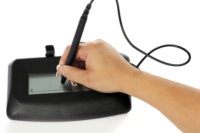Electronic signatures can be acquired through text-typing the customer’s name in a signature field, allowing them to “write” their signature into a mobile device with a touchscreen, or even through the phone. Solutions vary to fit different ways that companies do business. It isn’t always necessary to have a salesperson or technician at the customer’s home with a costly tablet computer to acquire an electronic signature.
In the security industry, electronic signatures are being used in several departments. John Brady, principal at TRG Associates, has seen a particularly beneficial use in contract renewals. “For companies in states where the Evergreen Clause (automatic renewal) is restricted — we are working with companies today that have the task of re-contracting their customer base as a whole or part as the old contracts expire,” Brady says. “The electronic means of providing and gathering the new contract is far easier for the customer and the company.” When it comes to renewals, “easier for the customer” could very well translate into a higher rate of completion.
Bryan Lawrence, attorney at Buchanan Ingersoll & Rooney's Security Alarm Group, notes that e-contracts can be just as solid as traditional contracts — as long as you’re informed. “For any alarm company thinking about electronic contracting, the first step is to understand the pros and cons in order to make an informed decision as to whether electronic contracting is right for its business.
“If an alarm company decides to move forward, then it needs to engage knowledgeable legal counsel to explain the legal implications of electronic contracting. It is also critical that it hire a company that is in the business of providing electronic contracting services — both to help streamline the process and to ensure the electronic contracts are capable of being retained and can be accurately reproduced at some later date. The bottom line is that no alarm company should engage in electronic contracting without a very thorough understanding of how the overall process works and without first putting in place the necessary safeguards to ensure that the contracts it creates will be valid and enforceable.”
NorthStar Alarm Services, headquartered in Orem, Utah, is using electronic signatures in its sales and retention departments to create contracts, extend its customer’s agreements and help them put their agreement on hold, among others. The company has been using this technology for nearly 18 months and has seen improvements in productivity as well as customer satisfaction.
“If we’re going to make a sale and have a customer call in to order a system, rather than sending them a copy of the contract and waiting for it to come back, it’s done in 10 minutes,” says Nick Nelson, inside sales agent and customer retention specialist at NorthStar. Once they’ve made the decision, they want the system in. The sooner we can get the agreement back, the sooner we can get a technician out. It’s made things 10 times faster.”
Many companies have made the leap to archiving paperwork electronically. Most of them rely on scanning individual paper documents so that they can be stored electronically. By eliminating the need to have a traditional pen-on-paper signature, that scanning step as well as the transfer of paperwork through departments is unnecessary.
Nelson comments that it’s certainly easier to keep track of electronic paperwork, though he adds that, “More than anything it’s provided ease for our customers to get things done.” NorthStar customers can make changes to their accounts, put them on hold, and establish agreements without seeing a single piece of paper, if they don’t want to. This is even an added advantage to customers that are interested in “green,” or environmentally conscious, initiatives. According to Nelson, the reduction in paper and postage costs is greater than what the company spends to get these electronic signatures.
The way NorthStar obtains electronic signatures did not require the purchase of any additional hardware. “It’s generally done through a phone call,” Nelson explains. “We send the customer an e-mail with the login information to access the documents, so they know it’s secure, and they can go in and electronically sign.”
Once the customer logs in, the electronic signature provider can use that information to populate information fields automatically. In NorthStar’s case, the login information is used to fill out the signature box with the customer’s name. All they need to do is click an “apply signature” button in order to legally agree to terms and conditions.
Brady notes that a practical electronic signature system requires some integration between security software developers and e-signature service providers. “Building a bridge from the contracting platform to your customer base information is the challenge,” Brady explains, “but that is being worked on by a number of the software providers in our industry and a number of the e-contract providers at this time to facilitate a smooth transition of the customer information over to the contract. This will eliminate all the handwriting, mailing and waiting for return of documents from new customers.”
Nelson has observed this first-hand. “I personally can do five to 10 of these every day rather than handwriting out and mailing each one,” he says. “It cuts my time at least in half and allows me to work with other customers or take phone calls. When it comes back, it notifies me it’s been done. They’re then forwarded on to billing, tech support, service technicians, etc. We went from scanning paperwork, to just saving into the file.”
Concern for the validity of agreements that don’t bear a traditional signature has been all but laid to rest through The Electronic Signatures in Global and National Commerce Act at the federal level — also known as the e-Sign Act — and the Uniform Electronic Transactions Act (UETA) at the state level.
Though there are special considerations to be made for electronic contracts, those generally deal with disclosures to customers on how the electronic signature procedure works (how they can access, cancel or change their agreement, for example) rather than differences between an ink signature and an electronic one.
At a recent webinar hosted by e-signature provider E-Original, Lawrence stressed that, “the eSign Act did not do anything to change the basic rules of contracting. What its purpose was, as set forth in the Act, was to make clear that a signature, contract or other record could not be considered invalid or unenforceable just because it was done in an electronic format. In effect, this was an attempt to level the playing field between paper contracting and electrnic contracting.”
Lawrence also told SDM e-News, “Conversely, the E-Sign Act also provided that an electronic contract could be invalid or unenforceable if the electronic record was not capable of being retained and accurately reproduced for later reference.”
Brady adds that through electronic storage, electronic contracts are more practical than paper contracts and that makes them just as valuable, if not more, as paper contracts. “The value of these contracts as bank collateral or in market transactions is not affected and in fact, providers such as E-Original can facilitate secure storage and access to your records for both the company, the bank and customer all at once,” he says.
As far as special contractual considerations for the alarm industry, Lawrence notes, “Alarm contracts are different from most other consumer contracts in that the alarm company wants to use the contract to both set forth the terms of sale and to limit its liability in certain situations. Consequently, it is very important to an alarm company that it not do anything vis-a-vis electronic contracting that might call into question the validity or enforceability of its contracts. One particular area of concern involves consumer notices, such as the 3-day notice of cancellation. It's critical that an alarm company make sure that it is providing all consumer notices in accordance with the requirements of the E-Sign Act because, it fails to do so (and there are very specific requirements), then it runs the risk of having an electronic contract that is not enforceable.”
Brady adds, “This method of contracting a security customer is the way of the future much like a number of other industries (car loans, Internet purchases, etc.) have been doing for years.”





